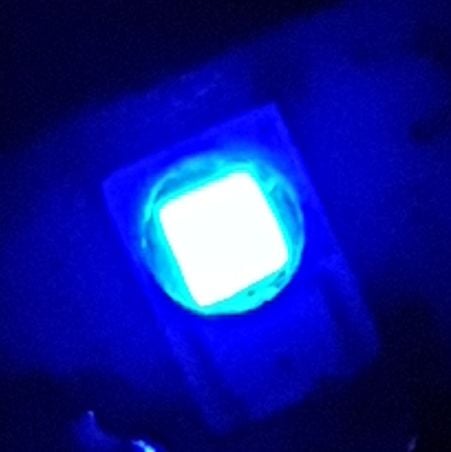Modelling of Light-Emitting Diodes (2009-2019)

In this project, we studied the optical properties of light-emitting diodes (LED) that were aged over several years. High-accuracy spectral measurements at varied operating temperatures were carried out to derive the complex relationships between the operating temperatures, spectra, and ageing of LEDs and lamps consisting thereof.
Based on the data gathered, we developed state-of-the-art spectral models describing the electroluminescence spectra of AlGaInP and InGaN LEDs that are the most efficient and most common semiconductor alloys able to produce visible radiation. Our spectral models take into account the effective optical joint density of states (JDOS) that depends on the materials and geometrical dimensions used and its thermally induced occupation probability, modelled by weighting the JDOS with the Maxwell-Boltzmann distribution. One spectrum at a known temperature for one LED specimen is needed for calibrating the model parameters of each LED type. Then, the model can be used for determining the junction temperature optically from the spectral measurement, as the junction temperature is one of the free parameters.
The models developed [1, 2] were validated using multiple spectra of AlGaInP and InGaN LEDs measured at various current levels and temperatures 303 - 398 K. The models work with an uncertainty of a few kelvins and they are able to model both sides of the spectra. A correlation was found between the junction temperatures of the LEDs and their life times. The higher the junction temperature, the shorter the life time. Part of the measurements were carried out at cryogenic temperatures. [3] Also a simpler model, relying on a spectral invariant point in the LED spectra measured at varied temperatures was developed and tested [4].
Contact persons: Petri Kärhä, Anna Vaskuri, and Hans Baumgartner
References
[1] A. Vaskuri, H. Baumgartner, P. Kärhä, G. Andor, and E. Ikonen, "Modeling the spectral shape of InGaAlP-based red light-emitting diodes," Journal of Applied Physics 118, 203103 (2015).
[2] A. Vaskuri, P. Kärhä, H. Baumgartner, O. Kantamaa, T. Pulli, T. Poikonen, and E. Ikonen, "Relationships between junction temperature, electroluminescence spectrum, and ageing of light-emitting diodes," Metrologia 55, S86–S95 (2018).
[3] Elvira Martikainen, Anna Vaskuri, Timo Dönsberg, and Erkki Ikonen, “Cryostat setup for measuring spectral and electrical properties of light-emitting diodes at junction temperatures from 81 K to 297 K,” Review of Scientific Instruments 91, 015106 (2020). https://doi.org/10.1063/1.5125319
[4] Hans Baumgartner, Anna Vaskuri, Petri Kärhä, and Erkki Ikonen, “Temperature invariant energy value in LED spectra,” Appl. Phys. Lett. 109, 231103 (2016); doi: 10.1063/1.4971831